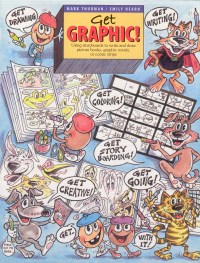| ________________
CM . . .
. Volume XVII Number 5. . . .October 1, 2010 
 |
Get Graphic! Using Storyboards to Write and Draw Picture Books, Graphic Novels, or Comic Strips.
Mark Thurman & Emily Hearn.
Markham, ON: Pembroke, 2010.
94 pp., pbk., $24.95.
ISBN 978-1-55138-252-4.
Subject Headings:
Creative writing (Elementary education).
Creative writing (Secondary education).
English language-Composition and exercises-Study and teaching (Elementary).
English language-Composition and exercises-Study and teaching (Secondary).
Storyboards.
Pictures in education.
Professional: Grades 5 and up.
Review by Ann Stinner.
**** /4
|
| |
|

The subtitle of Get Graphic!: Using Storyboards to Write and Draw Picture Books, Graphic Novels or Comic Strips tells us right at the outset what the focus of this book will be. Creators Mark Thurman and Emily Hearn have used their combined experiences as artists/writers and as presenters of workshops both for children and teachers to assemble an excellent, practical compendium on how to use storyboards. They also, by extension, guide readers to developing a broader media literacy. As the authors write in the "Introduction":
...storyboards free young writers to focus on language and build skills connected to highly visual media where words, few but apt, must resonate. Focusing on the visual helps students appreciate how pictures affect the viewer emotionally. It makes students more aware of how TV, computer games, and all forms of media strive to influence them with words and visuals.
For students or teachers looking for clear instructions on how to "design" a story for an illustrated book -- inventing the story, using language economically to tell the story, laying out the plot visually, creating a rough mock-up and then a finished copy -- there are helpful steps laid out. Bold black-and-white drawings illustrate each stage of the process, and, in contrast to many of the "how-to" manuals available on this topic, this book offers a range of creative options to think about at each of these stages. Students are led to consider thoughtful design as an important component of any original picture book, comic strip or graphic novel.
As a former teacher, I find certain sections of Get Graphic! to be especially useful, whether the book is to be used by educators (or parents) or by young people on their own. The "Read, Read, Read" section at the beginning, for instance, contains a list of exemplary picture books which readers are encouraged to study in order to reinforce the visual and written storyboarding concepts emphasized by Thurman and Hearn. This "research" phase--whether done as a class, in small groups, or by individual younger or older students--is an essential part of the idea development for a book project. Another valuable part of the book is the "Drawing by Drawing" section which offers assistance with some of the technical problems that book designers/illustrators face: for example, showing depth (with landscape, buildings and/or figures), creating variety in points of view, injecting visual surprises, and thinking about different ways of representing light and shadow. At every stage, Get Graphic! avoids a formulaic approach by encouraging individuality and suggesting a range of options. Sections on the different ways of using collage and of designing lettering for visual impact are especially strong in this regard. (One small regret: a few pages of colour illustrations might have helped to highlight the powerful potential of colour in book and graphic design. Presumably, the cost of such an addition would have made the book less accessible to a wide range of readers.) In general, Get Graphic! answers clearly, through both illustrations and written explanations, the questions that readers of all ages are likely to have about how to create a picture book, graphic novel or comic strip. Additional helpful material is included in a reference section at the end of the book: a glossary of art terms ("The Way an Artist Speaks"), a summary of illustration ideas and an overview of double-page storyboard templates.
Thurman and Hearn's book is a must for public libraries and for middle years and senior years school libraries. Art or classroom teachers who are striving to link visual and written languages in their programs would also find it valuable for themselves and their students. And Get Graphic! would make a great addition to the home library of any young artist labouring over his or her first comic strip or graphic novel.
Highly Recommended.
Ann Stinner is a book artist and former art education instructor in the Faculty of Education at the University of Manitoba in Winnipeg, MB.

To comment
on this title or this review, send mail to cm@umanitoba.ca.
Copyright © the Manitoba Library Association. Reproduction for personal
use is permitted only if this copyright notice is maintained. Any
other reproduction is prohibited without permission.
NEXT REVIEW |
TABLE OF CONTENTS FOR THIS ISSUE
- October 1, 2010.
AUTHORS |
TITLES |
MEDIA REVIEWS |
PROFILES |
BACK ISSUES |
SEARCH |
CMARCHIVE |
HOME |
